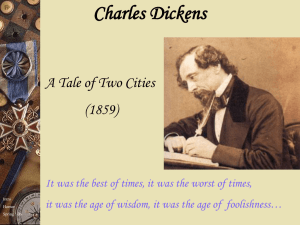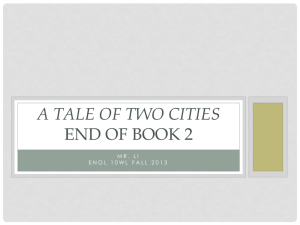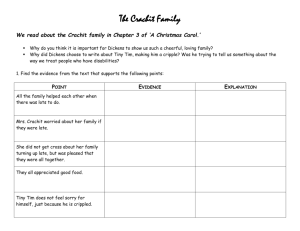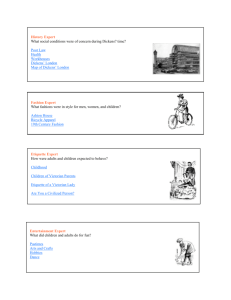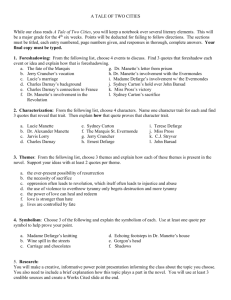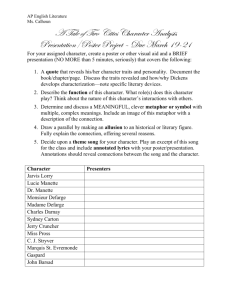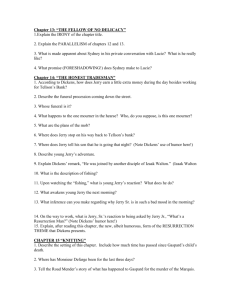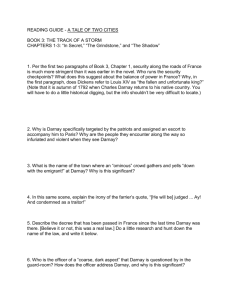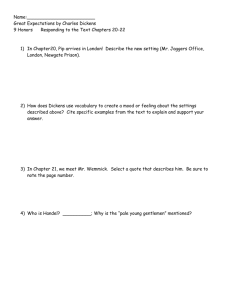ToTC Essay Powerpoint
advertisement
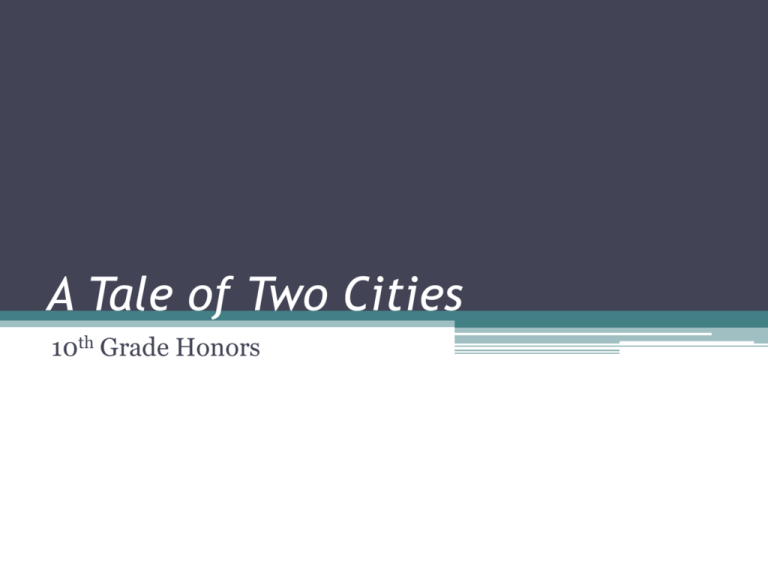
A Tale of Two Cities 10th Grade Honors Things You Did Well • Excellent overall understanding of the text • BETTER job of stating CLAIMS in your topic sentences • Nice creative hooks and introductory paragraphs • Polished writing overall • BETTER use of themes Things To Work On • Stating Claims CLEARLY • Addressing the prompt ▫ Presenting WARNINGS ▫ Presenting MESSAGES to Dickens’ audience • Incorporating THEME and SIGNIFICANCE into claims ▫ Strengthening claims • Using ANALYSIS to move from the text to significance / personal insight Using Topic Sentences to Organize a Paragraph • Topic Sentence: Dickens utilizes the symbols of the Gorgon, the knitting, and the Lodestone Rock to warn the English people of his day about the dangers of ignoring the wrongs of the past. ▫ Claim #1: The Gorgon is a symbol associated with the French nobility that represents the coldness by which the nobility have treated the peasants in the past. This is eventually rebounded back onto them revealing how past wrongs will not go unpunished. ▫ Claim #2: Madame Defarge’s knitting represents the inevitability of vengeance for past wrongs as characters associated with the terrible atrocities committed by the nobility are placed into the knitting and eventually killed. ▫ Claim #3: The Lodestone Rock represents the infeasibility of ignoring the past as Charles Darnay is drawn back to France despite his every attempt to renounce his titles and injustices that his family had caused. Addressing the Prompt • RECALLED TO LIFE: In an expository essay using the concept of theme, discuss the “Recalled to Life” motif in A Tale of Two Cities by tracing its presence in the novel and making a claim about how it contributes to the overall message that Dickens presents to his readers. • SOCIAL CRITICISM: In an expository essay, discuss how Dickens utilizes plot, characters, motifs/imagery, symbolism, historical events, etc. to send a message to the English people of his day. Be sure to focus on the critiques / social commentary that Dickens employs in his novel and emphasize how this leads to a prophetic warning involving the people of his day. • CHARACTER ANALYSIS: In an expository essay, utilizing character comparisons, discuss how Dickens reveals aspects of society (both French and English) and make a claim about the message that Dickens sends to his readers. • ROLE OF WOMEN: In an expository essay discuss the role and function of Dickens’ female characters (Madame Defarge, Lucie Manette, Miss Pross, the Seamstress, etc.) and make claims about the message that Dickens presents using those characters. • ROLE OF THE PAST: In an expository essay discuss the message the book makes about the past by examining Dickens’ use of characters, symbols, and motifs and relate this to the overall message that Dickens conveys to the English people of his time. Issues with Theme • Most of you STATED themes or warnings in your thesis and topic sentences ▫ HOWEVER, not all of you PROVED those themes by: 1) Making claims which REVEALED that theme 2) Returning to your themes in your examples using ANALYSIS Using THEME in your CLAIMS Strong claims made an argument about features of the text that REVEALS theme/significance (or a warning) • Just as the shoemaker’s bench kept Doctor Manette in the past, his daughter Lucie was the light that brought him out of the dark. The motif “recalled to life” is used when several characters break free from their pasts and look to the future. It signifies a person essentially enjoying the present and looking towards the future instead of focusing on what happened in the past. • People will do anything for Lucie because she is so virtuous and good. This is somewhat ironic because although Lucie is constantly seen as the beautiful and perfect woman, she in fact never specifically does anything to merit being thought of in that way. She is painted as the perfect stereotype of a Victorian woman, but there is no depth, making her a flat character. • Mr. Lorry’s transformation from a heartless “man of business” to a genuine friend and trustworthy member of the Manette family reveals how the transformative power of love can redeem the past. Which suggests that if London is to avoid suffering the same fate as the similarly cold and heartless Monseigneur, it must establish bonds of love among its citizens. Weak Claims • Weak claims don’t make strong points about the text that can be connected to SIGNIFICANCE A different reaction to love is Carton’s. The past is brought up for many of the characters because of the vengefulness of one particular character, Madame Defarge. Charles Darney is an example of a character whose past comes back to haunt him. The Vengeance symbolizes Madame Defarge’s past. Madame Defarge, the woman who started the revolution, is always knitting throughout the beginning of the novel. Strengthen the following Claims • Add theme/significance to the following claims: ▫ The symbol of the wine keg spilling is used to represent the barbarous aspects of the revolutionaries ▫ Sydney Carton is recalled to life from his previously alcoholic and depressing state of being by Lucie Manette. ▫ Mr. Lorry is also lost in the beginnin gof the book he is just a hard-working businessman and by the end of the book he is loved by Lucie’s whole family. Stating Claims Clearly Early on in the novel, a wine keg falls off a cart and spills, leaving puddles of dark red liquid mixed with the grime of the cobblestone road. The wine spilled on the ground and smeared on the hands and faces of the peasants represents the blood of the aristocrats. The peasants lap up the muddy wine like dogs: “Some men kneeled down, made scoops of their two hands joined, and sipped, or tried to help women, who bent over their shoulders, to sip, before the wine had all run out between their fingers” (Dickens 29). One man, Gaspard, writes the word “Blood” on a wall near the spill, verifying the wine’s resemblance to blood. The poor are desperate for food and drink. They are starving and dying, but are still treated as animals of no importance by the rich. The wine represents blood of the aristocrats that will soon be spilled with knives of the desperate and guns of the starved. Using THEME in ANALYSIS of TEXT • Make a claim that ADDRESSES THE PROMPT using theme (Topic Sentence) ▫ In the novel, Charles Dickens uses the motif of the “Echoing Footsteps” to further the idea to the English people that the past is infinitely present and will affect one’s life. • Explain how the author REVEALS that claim using features of the text (symbols, motif, characters, etc.) ▫ Towards the end of the novel, Lucie hears footsteps upon the steps right before Manette’s and Darnay’s pasts come back to them, which additionally proves the meaning of the Enchoing Footsteps to be one’s history following them. • Use evidence to prove your claim ▫ Lucie is sitting with her family, when all of a sudden she gasps in fear due to the Footsteps that she hears: “’What is that? [Lucie] cried, all at once. […] ‘I thought my father,’ said Lucie, excusing herself, with a pale face and in a faltering voice, ‘that I heard strange feet upon the stairs.’ ‘My love, the staircase is as still as Death.’ As he said the word, a blow was struck upon the door,” (225-226). Lucie is alarmed when she hears echoing footsteps upon the stairs, her father says it is nothing, but it is indeed. The guards come in to declare that Charles Darnay will be put back on trial tomorrow. The main piece of evidence used against him in the trial is a letter that Manette wrote about the horrible Evremonde family, and how they should receive no mercy. • Use ANALYSIS to reconnect back to the prompt ▫ Due to the fact that Manette wrote the letter about Charles’ family, both of their pasts come back right after the footsteps are heard. The Echoing Footsteps foreshadow terrible things that happen which can be connected to the past, and therefore reveal a message to the English people that the past is silently following until it is ready to emerge and disrupt the present. Using ANALYSIS The following claim-evidence is missing analysis/significance. Add it in. • Claim: Dickens proves that love overcomes hate and fear and when combined with the courage to do the unthinkable, the results are stupendous • Evidence: At the end of the book, Carton speaks to the reader from the grave and his words are serene and all-knowing: “It is a far, far better thing that I do, than I have ever done; it is a far, far better rest that I go to than I have ever known” (292). Carton’s death gives meaning to his life, for which he is happy as he lived his entire life believing he could do no good and allows him to die peacefully knowing his actions gave peace to the life of Lucie and those she loved. His love for Lucie was so pure and so deep that he sacrificed what was most sacred just for her. • Analysis/ Significance: ? Using Analysis The following claim-evidence is missing analysis/significance. Add it in. • Claim: Dickens utilizes parallels between France and London to reveal how London shares some of the same issues that caused the bloody revolution in France. • Evidence: When the wine keg spills in Saint Antoine, the peasants are shown to lap up the wine from the streets, foreshadowing how the peasants will one day drink the spilt blood of the nobility as vengeance for the wrongs that were inflicted upon them. Similarly, when Darnay (a gentleman) is put on trial in London at the Old Bailey, a crowd gathers to witness the trial and they are described as “a cloud of great blue-flies” who “[swarm] about the prisoner, in anticipation of what he was soon to become” (50). Like blue-flies which feed on carrion, the English crowd gathers to witness Darnay’s sentence, almost eagerly awaiting the promise of his gruesome punishment (quartering). • Analysis/ Significance: ? Textual Evidence Showing vs. Telling The theme that the past has a big effect on people in the present, making it difficult to overcome their past decisions, connects to Madame Defarge wanting revenge. ▫ She could only think about how horrible the aristocracy was and it made her go a bit insane. Dickens points out to the readers that they need to focus on the present and not let the past swallow up their lives. He uses the knitting to represent this. VS ▫ Madame Defarge’s need for revenge consumes her to the point where she no longer feels joy in the triumphs of the present. This is revealed when, after long last the Revolution finally occurs, her husband exclaims “At last it is come, my dear!” to which Madame Defarge replies […] “Almost” (174). Even after the two of them finally spearhead an event that they have been waiting centuries to occur, Madame Defarge cannot be satisfied due to her unwillingness to let past injustices alone. This eventually leads to her downfall and reveals how the past should not be allowed to consume one’s life in the present. AWESOME Intro Paragraph How can a beloved football coach go from having a spotless reputation to being a tragic figure in one of the worst scandals in college football history? Why is a man falsely imprisoned for five years then abruptly freed? What drives an average college pitcher to dramatically change his work habits to become the number one draft pick in Major League Baseball? A negative action can cause a negative backlash later on, a doomed life can become a revived soul, and a monotonous path can become an adventurous trail. Reciprocity, resurrection and redirection: these are attributes of the Recalled to Life theme that resonates in 21st century America just like it does in Charles Dickens’, 19th century fiction, A Tale of Two Cities. Just like reporters tell the story of Joe Paterno, an iconic 50 plus year coach who fell from grace because he covered up the acts of a molester, Dickens writes how the power of reciprocity works through the Marquis when he mistreats his subjects, and then, in the end, gets murdered for it. In 2013, Garry Diamond probably experienced a resurrection after being exonerated following a false conviction in 1977 in Texas for rape. Charles Dickens illuminates a similar profoundness of resurrection with Dr. Manette who starts life as a young successful surgeon and then is imprisoned unlawfully by nobles. Then, 18 years later, he is finally released and is restored to life by his Lucie Manette. Steven Strasburg was a below average college baseball player, out of shape and chastised by his coaches. But, he changed his work habits, changed direction, and became great. Dickens shows this type of redirection through Mr. Lorry. He had been a businessman since he was young, and hadn’t changed until he decided to help Dr. Manette by bringing his daughter from England to France. Mr. Lorry continued in a new direction and started to do things for other people and not for himself. The Recalled to Life theme, in which a negative action today can cause a negative backlash tomorrow, a doomed life can become a revived soul, and a monotonous path can become an adventurous trail are shown by Charles Dickens throughout the book.
